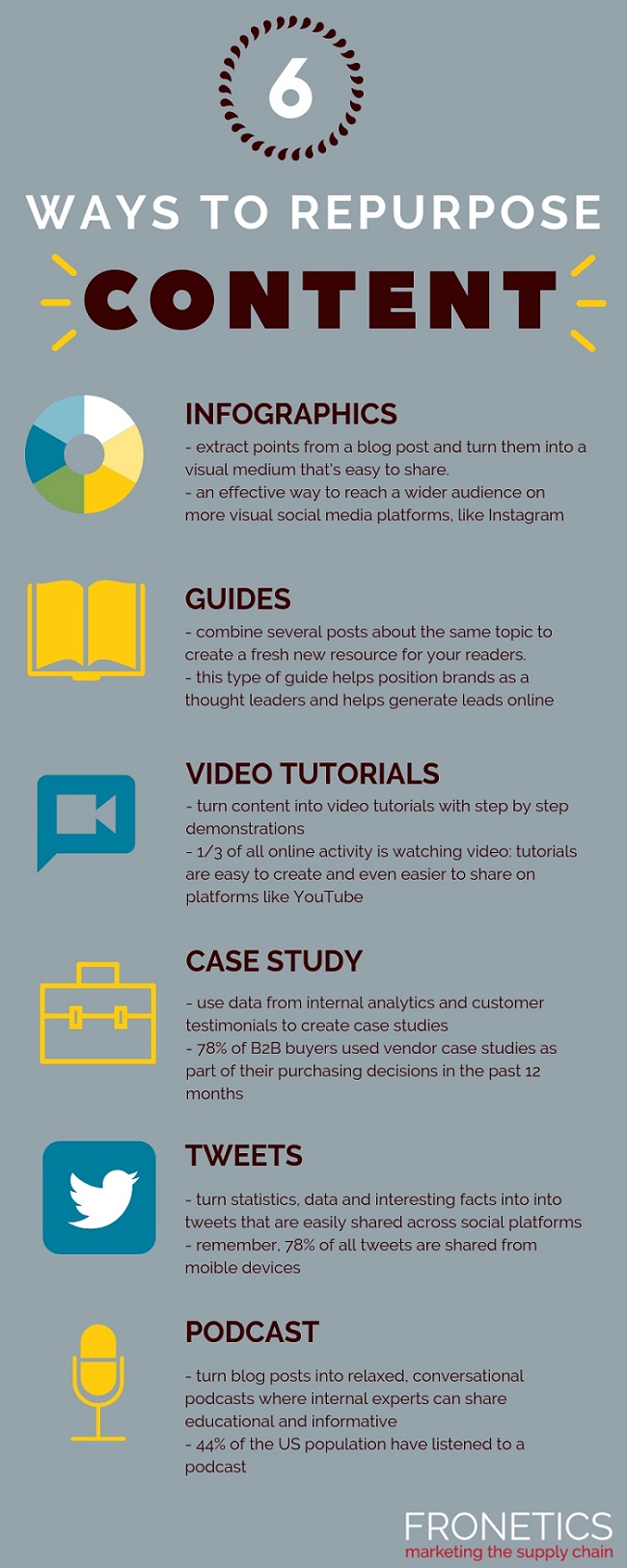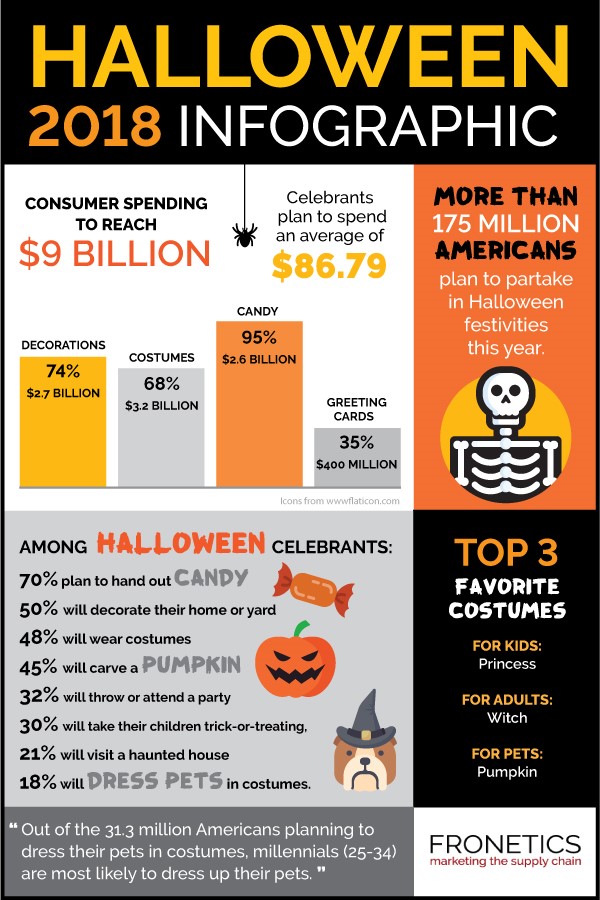
by Fronetics | Dec 13, 2018 | Blog, Content Marketing, Logistics, Marketing, Supply Chain
These are the top 10 most-viewed supply chain and logistics posts of 2018.
Our goal throughout the year is to provide our readers with the latest news and happenings in the supply chain and logistics industry, with a focus on content marketing. We hope to educate and enlighten our readers with industry insight, tips, and trends to stay ahead of the competition.
This year we’ve taken a deeper look at supply chain and logistics companies that have experienced the highs (Google, Amazon) and lows (Tesla, KFC) of running supply chain and logistics businesses. These posts have highlighted how we can all learn a thing (or two) from their accomplishments and, of course, their mistakes.
[bctt tweet=”This year we’ve taken a deeper look at supply chain and logistics companies that have experienced the highs (Google, Amazon) and lows (Tesla, KFC) of running supply chain and logistics businesses. These posts have highlighted how we can all learn a thing (or two) from their accomplishments and, of course, their mistakes.” username=”Fronetics”]
Here’s a look at our most popular supply chain and logistics posts this year.
Top 10 supply chain and logistics posts in 2018
1. 10 Must-Follow Supply Chain and Logistics Blogs in 2018
What are your favorite supply chain and logistics blogs? Fronetics wants to tell you about some of our favorite blogs that we follow. Read full post
2. Drawing Lessons from Tesla’s Supply Chain Issues
This guest post from Argentus Supply Chain Recruiting examines Tesla’s recent supply chain woes. Argentus also shares the biggest takeaways to help you prevent similar blunders. Read full post
3. Top 3 Logistics and Supply Chain Blogs of 2018
We love hearing what blogs you enjoy reading and find valuable. There are lots of great industry options, so we know it’s not easy to narrow down your favorites. We had lots of great responses, but only Women in Trucking held its spot on our list of the top logistics and supply chain blogs from last year. Read full post
4. KFC Ran Out of Chicken in the UK: What Supply Chain Lessons Can We Learn?
There’s another unfortunate entry in the annals of Supply Chain failures that burst into the wider world of business and pop culture: More than half of the UK’s Kentucky Fried Chicken stores closed because they ran out of chicken this year. Argentus Supply Chain Recruiting examines the lessons we can learn from the restaurant chain’s blunder. Read full post
5. How Google Does Supplier Diversity
In 2014, Google launched a supplier diversity program to ensure that its staff had the ability to search large and small vendors when purchasing products or services. The tool it developed has helped Google employees create relationships with small businesses, defined as U.S.-based companies with $15 million or less in annual revenue and 50 or fewer employees. Google felt these companies often have a specialized and innovative product or service but might never be discovered simply because of their size. Read full post
6. Infographic: Influencer Marketing and the Supply Chain
Influencer marketing is a form of marketing in which marketers identify individuals that have influence over potential buyers and create marketing campaigns and activities around these influencers. Why is this so effective? Because buyers trust influencers talking about your products and services more than they trust you talking about yourself. Read full post
7. Valentine’s 2018 Supply Chain Infographic
Consumers spent a near-record $19.2 billion on Valentine’s Day 2018, up from $18.2 billion in 2017. According to NRF’s annual survey, over half of the country participated (55%) in the romantic holiday, spending just over $140 on average. Read full post
8. Five Go-To Supply Chain Websites
Following leading websites is a great way to keep up with the latest news and information about happenings in the supply chain and logistics industry. Here are our five favorite supply chain websites. Read full post
9. Video: Why Inbound Marketing is Better than Outbound Marketing for Supply Chain Marketers
Marketers are constantly coming up with new and trendy ways to attract leads. With endless platforms available to us, it can be overwhelming for even the most seasoned marketers to know where they need to focus their efforts. Outbound marketing used to be the ‘go to’ for generating leads, but this is simply no longer the case. Marketers across industries have found that inbound marketing has many advantages over traditional marketing practices. Read full post
10. 5 Email Marketing Trends Supply Chain and Logistics Marketers Need to Know
More people are using email than ever before (close to 3.8 billion worldwide). Fronetics works with supply chain and logistics businesses every day, so we have a first-hand understanding of how email marketing can be successful in these industries. Read full post
Related posts:


by Fronetics | Dec 4, 2018 | Blog, Content Marketing, Logistics, Marketing, Strategy, Supply Chain
Repurposing content is an efficient way to reach a broader audience and build brand awareness.
You spent hours pouring over stats and interesting facts for a blog post. Don’t let all of that effort fall to the wayside. Breathe new life — and reach new audiences — by repurposing that content into engaging new formats.
Some social users like video, while others prefer pictures or podcasts. Taking content and changing its original format is just smart business. Repurposing high-quality content saves marketers time and money and helps to reach a broader audience.
Be picky
Not all of your blog posts and content get the same attention, and that’s ok. Some pieces will resonate more, increasing engagement and driving website traffic.
Run analytics on your content and see what pieces have performed the best. Use tools like Google Analytics to determine your most popular blog posts, your most engaged tweets, or your most viewed videos. This data will help you decide which content should be repurposed. The idea is to take one piece of content and gain visibility and expand your audience by turning it into multiple pieces of content.
The Rule of 7
Repurposing content isn’t just about cutting and pasting content. Have you heard of the Rule of 7? The Rule of 7 is a marketing principle that states your prospects need to encounter your content seven times before they take notice. That’s right, seven times.
[bctt tweet=”The Rule of 7 is a marketing principle that states your prospects need to encounter your content seven times before they take notice. That’s right, seven times.” username=”Fronetics”]
Repurposing content is a great way to take high-quality content and continue to get it in front of audiences without seeming redundant. HubSpot reports that brands who blog around 16 times or more per month get 3.5 times more traffic and 4.5 times more leads than businesses that blog fewer than four times a month. Frequency clearly gets results, but it can also be incredibly time-consuming to create new content 16 times every month. Repurposed content can help your marketing team increase frequency while focusing on quality.
Infographic: 6 ways to repurpose content

(Made with Canva)
Takeaway
How much value does your company put on content? It may be even more important than you think. Use these tips to repurpose high-quality content or yet better, start creating content with these tips in mind. Thinking about a topic and how you can turn that topic into multiple pieces of content will help your hard work go further and perform better.
Related posts:


by Fronetics | Nov 27, 2018 | Blog, Content Marketing, Current Events, Logistics, Marketing, Social Media, Supply Chain
With the 2018 holidays approaching fast, customers are pulling out their wallets and getting ready to increase holiday spending by at least 4.3%.
The National Retail Federation (NRF) is estimating that holiday sales will be up 4.3-4.8% over 2017, for a total of $717.45 billion to $720.89 billion. “Thanks to a healthy economy and strong consumer confidence, we believe that this holiday season will continue to reflect the growth we’ve seen over the past year,” says NRF President and CEO Matthew Shay.
[bctt tweet=”The National Retail Federation (NRF) is estimating that holiday sales will be up 4.3-4.8% over 2017, for a total of $717.45 billion to $720.89 billion.” username=”Fronetics”]
Shopping insights
Consumers are planning to spend an average total of $1,007 for decorations, candy, and gifts ($853 on average), as well as other purchases for themselves and their families ($154 on average). This is an increase from 2017, continuing the trend of growth over the past 5 years.
Not only are they spending more, but consumers are starting early this year—as many as 40% will have started their holiday shopping by November 1, and 18% got started in September or earlier.With Black Friday and Cyber Monday behind us, consumers have been using deals and promotions to start getting items on their holiday lists. 164.6 million shopped or considered shopping during the Thanksgiving holiday weekend.
Increasingly, shoppers are turning online, many on mobile devices. 71% are planning to use a smartphone or tablet to research or make a purchase. In fact, 55% of consumers are planning to shop online. Of those, 94% plan to take advantage of free shipping, 50% plan to buy online and pick up in store, and 16% plan to splurge on expedited shipping.
Priorities
Holiday shoppers rank sales and price discounts (71%), quality (60%), selection of merchandise (60%), and free shipping (47%) as the top factors in deciding where to shop this year.
“Consumers will be scouring through retailers’ ads to make sure they are getting the best deal possible,” Prosper Insights Executive Vice President of Strategy Phil Rist said. “Although sales will remain an important factor, shoppers want good quality and want to be able to find what they’re looking for.”

(Made with Canva)
Related posts:


by Fronetics | Nov 19, 2018 | Blog, Content Marketing, Logistics, Marketing, Supply Chain
For B2B buyers, case studies are still the most popular type of content. Check out our infographic below to discover the five elements of an effective B2B case study.
Did you know that 89% of B2B marketers consider customer testimonials and case studies to be the most effective kinds of content in converting buyers? A well-written case study engages prospects and generates leads. But what is an effective case study? And how do you create one?
[bctt tweet=”Did you know that 89% of B2B marketers consider customer testimonials and case studies to be the most effective kinds of content in converting buyers?” username=”Fronetics”]
These five elements are the key to maximizing the effectiveness of your case study:
1. Story
While it’s true that case studies are about the data, what makes them attractive to buyers is the story. This isn’t a sales pitch — it’s an opportunity to use data and testimonials to present a narrative to prospects about how your products and services helped another business.
2. Information and education
Think of your case study as an opportunity to educate your prospects about how your business has helped organizations similar to their own. Again, this is not a sales pitch. In fact, case studies that are written as sales pitches tend to be ineffective. A case study gives your prospects information and educates them so they can make an informed decision about what’s best for their business.
3. Concrete examples
Case studies are data-driven and offer concrete examples. This is one of the primary reasons they are a high-performing content type. An effective case study makes it easy for readers to find the information they’re looking for, using elements like bullet points, quotes, and lists to clearly and concisely convey key data.
4. The right length
There’s a delicate balance between presenting complete information, telling a story, and avoiding minutia that’s too specific to matter to your prospects. Ideally, you want your reader to be able to skim quickly and get an overall view, and then dive back in for more details. If your case study leaves your prospect with questions about how your products and services helped another business, chances are it doesn’t include enough information.
5. A simple outline
- The Challenge: What challenge or challenges was your customer facing before working with you?
- The Solution: How did your business address the challenges your customer was facing?
- The Results: How do your metrics demonstrate the immediate and ongoing results of your solution?

(Made with Canva)
The takeaway
Case studies are your opportunity to use your successes to create a narrative, supported by key metrics, that demonstrates how your business successfully addressed the challenges faced by your customers. Telling a compelling story is one of the best ways to engage your prospects and convert leads.
Related posts:


by Fronetics | Oct 25, 2018 | Blog, Current Events, Supply Chain
U.S. Consumers plan to spend a whopping $9 billion, the second highest spending amount in 14 years, on costumes, candy, decorations, and more to celebrate Halloween this year.
The National Retail Federation anticipates spending for Halloween in 2018 will come close to last year’s $9.1 billion all-time record.
[bctt tweet=”“The economy is good, and consumer confidence is high, so families are ready to spend on Halloween this year,” NRF President and CEO Matthew Shay said.” username=”Fronetics”]
“The economy is good, and consumer confidence is high, so families are ready to spend on Halloween this year,” NRF President and CEO Matthew Shay said. “Retailers are stocking up to supply children, pets, and adults with their favorite decorations, candy, and costumes for the season.”
The NRF’s annual survey found that 175 million Americans will celebrate the holiday, with over half of celebrants planning on dressing in costume. Expect to see plenty of Disney princesses, Star Wars characters and superheroes at your door.
Pet costumes are still the rage with nearly 20% of celebrants planning to dress up their pet this year. “Out of 31.3 million Americans planning to dress up their pets in costume, millennials (25-34) are most likely to dress up their pets, the highest we have seen in the history of our surveys.”
Pumpkin won out as the top pet costume (11%), with hot dog not far behind (7.6%). Will you be dressing up your dog or cat this Halloween?
Check out our infographic of other interesting Halloween 2018 facts from the NRF’s survey of 6,961 consumers below.
Infographic: Halloween 2018

(Made with Canva)
Related posts:














